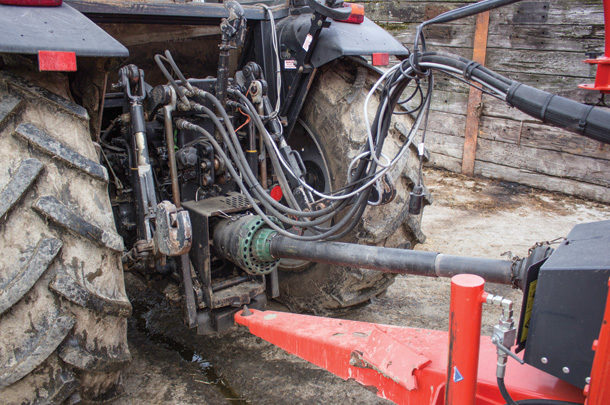The “hurry up and get it done” mindset is ingrained in most people on the farm. We tend to be in a hurry and often don’t take the time for safety.
Most people believe they will not get hurt at work, but every farmer I know has a story or two about a fellow farmer who was injured doing a day-to-day task.
On most farms, using power take-off (PTO)-driven equipment is a regular occurrence. Even though you may be very experienced working with or around a PTO, the hazards are still very real and need to be considered each time you complete a task using this type of equipment. PTO shafts are the leading cause of entanglement fatalities, which account for 30% of agricultural fatalities in Canada. There were 14 deaths caused directly by PTO shafts from 1998 to 2008 in Canada.
PTO shafts typically turn from 540 to 1000 rotations per minute (rpm) and in less than one second, operators can be pulled into and torqued around PTO shafts. Most PTO entanglement injuries end in permanent dismemberment or death.
A PTO shaft operating at 540 rpm makes nine complete rotations every second. If the PTO shaft is 4 inches in circumference, this means 36 inches of shirtsleeve or an entire arm can wrap around the PTO shaft in just one second. Other PTO shafts rotate at 1,000 rpm, or 16.6 times per second. It only takes half a second to entangle an entire arm or leg at this speed.
When you are required to use a PTO shaft, safety should always be your top priority. It is important to inspect the PTO before, during and after use. You should always complete the following inspections.
Pre-operational inspection of PTO
Inspect the PTO to ensure that all components, including the shield and guards, are in place and properly secured. Ensure the master shield is in place where the PTO meets the tractor or equipment. Test driveline guards by spinning them to ensure they have not become stuck to the shaft. Finally, ensure the PTO rotates freely.
Operational safety checks
When using the PTO for silage blower, grinder-mixer, irrigation and manure pumps, remain at a minimum 6 feet distance from the PTO shaft. When a PTO is in use, ensure that safety pylons are placed around the equipment. Never leave a PTO unattended. Do a complete shutdown of the PTO and equipment before leaving the area. Always walk around instead of stepping over the PTO shaft, even when it is not rotating. Never work around a PTO with loose or torn clothing, long hair, jewelry, etc. Finally, be aware of who is in your area when operating a PTO. Ensure animals and children are not in the area, and that other employees know you are working with a PTO and they understand the rules to working around a PTO shaft.
Ending operations
Disengage the PTO before shutting the machine off to keep the PTO from turning at start-up. Turn off tractor/equipment before dismounting to clean, repair, service or adjust the PTO or attachments. Conduct a routine inspection to identify any maintenance required on defective or worn parts, guards or shields.
Training
It is important to make sure anyone who is working with or around the PTO has been trained and evaluated to ensure they understand the safety procedures. Document the training and keep it on file.
Other important things to note
Though not always convenient or easy, there are several ways to reduce the risk of PTO injury incidents. The safety practices listed below offer protection from the most common types of PTO entanglements.
- Always use the driveline recommended for your machine.
- Position the tractor’s drawbar properly for each machine used to help prevent driveline stress and separation on uneven terrain and during tight turns.
- Reduce PTO shaft abuse by avoiding tight turns that pinch rotating shafts between the tractor and machine. Keep excessive telescoping to a minimum, engage power to the shaft gradually, and avoid over-tightening of slip clutches on PTO-driven machines.
- Be sure PTO shaft is securely locked onto the tractor PTO stub shaft.
- Keep universal joints in phase.
- Lubricate bearings regularly, as recommended by the manufacturer.
Remember that the PTO shaft turns faster than our reaction time. It is easy to get snagged into a turning PTO shaft. Always follow the safety precautions and keep others away from the PTO. Having a PTO guard can mean the difference between keeping your limbs and going home safely or not.










